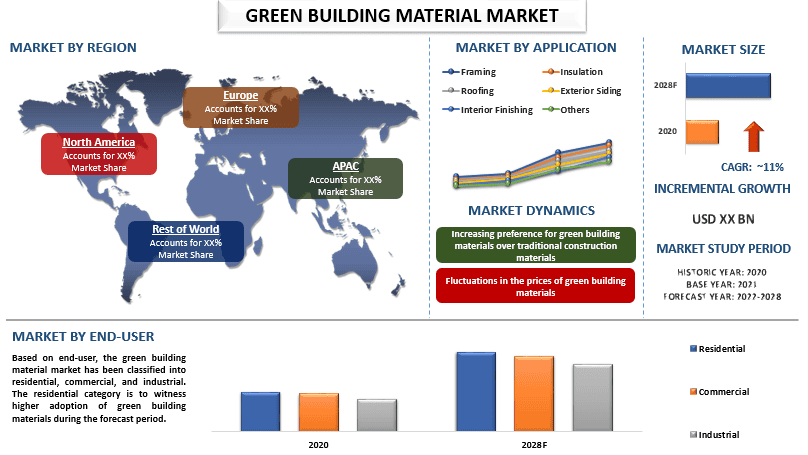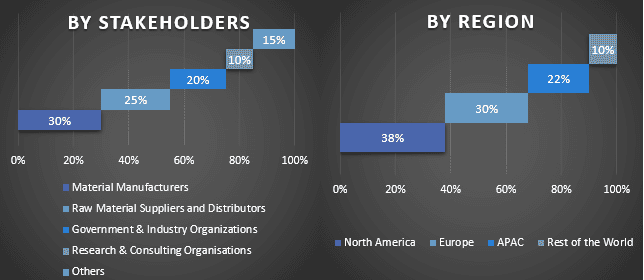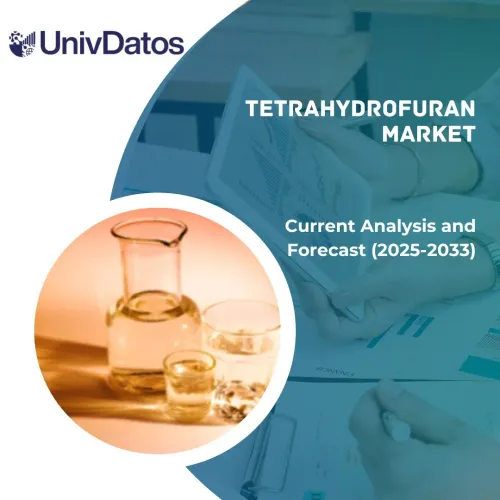
全球綠色建材市場預計在預測期內以約 11.2% 的顯著速度增長。 綠色建材又稱環保建材。 它可以定義為用於建造對環境影響低的建築物的建築材料。 它們由可再生資源組成。 近年來,由於人們越來越意識到綠色建材的優勢,以及越來越關注更好的隔熱和環保環境,對綠色建材的需求急劇上升。 例如,美國綠色建築委員會 (USGBC) 將黑森州評為德國 LEED 認證綠色建築數量最多的州。 黑森州擁有近 300 萬 GSM(克/平方公尺)的建築空間,包含 95 個 LEED 認證專案。
BASF SE、Owens Corning、CertainTeed Corporation、Sika AG、National Fiber Supply Inc.、PPG Industries Inc.、Alumasc Group Plc、RedBuilt LLC、LafargeHolcim Ltd. 和 Kingspan Group Plc. 是市場上的一些主要參與者。 這些企業已進行多起併購和合作,以發展綠色建材市場。
報告中提供的見解
“在應用中,隔熱類別預計在預測期內將出現更高的複合年增長率”
根據應用,市場分為框架、隔熱、屋頂、外牆、室內裝修和其他。 由於卓越的能源效率不斷提高,並且越來越重視安裝室內隔熱解決方案,隔熱類別預計在預測期內將出現更高的複合年增長率。 由於建築物隔熱不當,綠色建材被採用來提供建築物的回收建造。 此外,全球企業進入新興市場也促進了市場的成長。 例如,中國全地形車製造商 CFMoto 宣布計劃在印度市場推出其產品。
“在最終用戶中,住宅將在 2020 年佔據市場的很大一部分”
根據最終用戶,綠色建材市場分為住宅、商業和工業。 在預測期內,住宅類別預計將更多地採用綠色建材。 這主要是由於越來越多的建築法規和政策要求節能結構。 這為住宅建築中使用的環保和節能材料創造了市場。 例如,2020 年 5 月,SmartLam North America 和 RedBuilt 宣布建立合作夥伴關係,為建築師、工程師和承包商提供用於使用流行的大型木材建築技術專案的交叉層壓木材 (CLT) 產品和解決方案
“北美將在市場中佔據重要份額”
2020 年,預計北美在預測期內將以可觀的複合年增長率成長。 這主要是由於該地區新興經濟體推動了市場的成長,因此建築業使用的環保材料受到嚴格規範。 此外,應用範圍的廣泛擴張以及商業和住宅產業以及醫療保健領域的成長,預計將進一步支持綠色建材的市場成長。 此外,在許多改造和翻新應用中越來越多地實施綠色建築技術,進一步加速了該地區綠色建材市場的成長。 此外,市場上的主要企業繼續投資於綠色建材,以便在建築業中更先進地利用再生能源。 例如,根據美國綠色建築委員會 (USGBC) 的數據,2020 年,美國有 1,171 個專案通過了 LEED 綠色建築認證,土地面積達 2.8105 億 GSF。
購買本報告的理由:
- 該研究包括經過認證的主要行業專家驗證的市場規模和預測分析。
- 該報告快速回顧了整個行業的績效。
- 該報告深入分析了傑出的行業同行,主要關注主要業務財務、產品組合、擴張策略和最新發展。
- 詳細檢驗了行業中存在的驅動因素、限制、主要趨勢和機會。
- 該研究全面涵蓋了不同細分市場的市場。
- 深入的行業區域級別分析。
客製化選項:
全球綠色建材市場可以根據需求或任何其他細分市場進一步客製化。 此外,UMI 了解到您可能有自己的業務需求,因此請隨時與我們聯繫以獲得完全符合您需求的報告。
目錄
綠色建材市場分析的研究方法 (2022-2028)
分析歷史市場、估計當前市場和預測全球綠色建材市場的未來市場,是創建和分析全球主要地區全地形車採用情況的三個主要步驟。 進行了詳盡的二級研究,以收集歷史市場數據並估計當前市場規模。 其次,為了驗證這些見解,考慮了許多發現和假設。 此外,還與全球綠色建材市場價值鏈中的行業專家進行了詳盡的一級訪談。 在通過一級訪談對市場數據進行假設和驗證後,我們採用了自上而下/自下而上的方法來預測完整的市場規模。 此後,採用市場細分和數據三角測量方法來估計和分析行業相關的細分市場和子細分市場的市場規模。 詳細方法如下:
歷史市場規模分析
第一步:深入研究二級來源:
進行了詳細的二級研究,通過公司內部來源(如年度報告和財務報表、業績演示文稿、新聞稿等)和外部來源(包括期刊、新聞和文章、政府出版物、競爭對手出版物、行業報告、第三方數據庫和其他可靠出版物)來獲取綠色建材市場的歷史市場規模。
第二步:市場細分:
在獲得綠色建材市場的歷史市場規模後,我們進行了詳細的二級分析,以收集主要地區不同細分市場和子細分市場的歷史市場見解和份額。 報告中包含的主要細分市場是應用和最終用戶。 此外,還進行了國家/地區層面的分析,以評估該地區測試模型的總體採用情況。
第三步:要素分析:
在獲得不同細分市場和子細分市場的歷史市場規模後,我們進行了詳細的要素分析,以估計綠色建材市場的當前市場規模。 此外,我們使用因變量和自變量(如各種全地形車的各種應用和最終用戶)進行了要素分析。 考慮到全球綠色建材市場領域的頂級合作夥伴關係、併購、業務擴張和產品發布,對需求和供應側情景進行了徹底的分析。
當前市場規模估計和預測
當前市場規模:基於上述 3 個步驟的可行見解,我們得出了當前市場規模、全球綠色建材市場中的主要參與者以及各細分市場的市場份額。 所有必需的百分比份額分配和市場細分均使用上述二級方法確定,並通過一級訪談進行驗證。
估計和預測:對於市場估計和預測,權重分配給不同的因素,包括利益相關者的驅動因素和趨勢、限制和機會。 在分析這些因素後,應用相關的預測技術,即自上而下/自下而上的方法,以得出全球主要市場不同細分市場和子細分市場的 2028 年市場預測。 用於估計市場規模的研究方法包括:
- 該行業的市場規模,以收入(美元)和國內主要市場中綠色建材市場的採用率衡量
- 所有市場細分和子細分市場的百分比份額、分配和細分
- 全球綠色建材市場中的主要參與者,就提供的產品而言。 此外,這些參與者為在快速增長的市場中競爭而採用的增長策略
市場規模和份額驗證
一級研究:與主要意見領袖 (KOL) 進行了深入訪談,包括主要地區的高層管理人員(CXO/VP、銷售主管、行銷主管、營運主管、區域主管、國家/地區主管等)。 然後總結了一級研究結果,並進行了統計分析以證明所述假設。 來自一級研究的輸入與二級研究結果合併,從而將資訊轉化為可操作的見解。
不同地區的一級參與者分佈

市場工程
採用數據三角測量技術來完成整體市場估計,並得出全球綠色建材市場每個細分市場和子細分市場的精確統計數據。 在研究了全球綠色建材市場中應用和最終用戶領域的各種參數和趨勢後,數據被分成幾個細分市場和子細分市場。
全球綠色建材市場研究的主要目標
該研究指出了全球綠色建材市場的當前和未來市場趨勢。 投資者可以獲得戰略見解,以基於研究中進行的定性和定量分析來決定投資。 當前和未來市場趨勢決定了區域層面市場的整體吸引力,為產業參與者提供了一個利用未開發市場以從先行者優勢中受益的平台。 該研究的其他定量目標包括:
- 分析綠色建材市場當前和預測的市場規模,以價值(美元)計算。 此外,分析不同細分市場和子細分市場當前和預測的市場規模
- 研究中的細分市場包括應用和最終用戶領域。
- 定義和分析綠色建材的監管框架
- 分析涉及各種中介機構的價值鏈,以及分析產業的客戶和競爭對手行為。
- 分析主要地區綠色建材市場當前和預測的市場規模。
- 報告中研究的主要區域國家/地區包括亞太地區、歐洲、北美和世界其他地區。
- 綠色建材市場的公司概況以及市場參與者為在快速增長的市場中維持而採用的增長策略
- 對產業進行深入的區域層級分析
相關 報告
購買此商品的客戶也購買了










